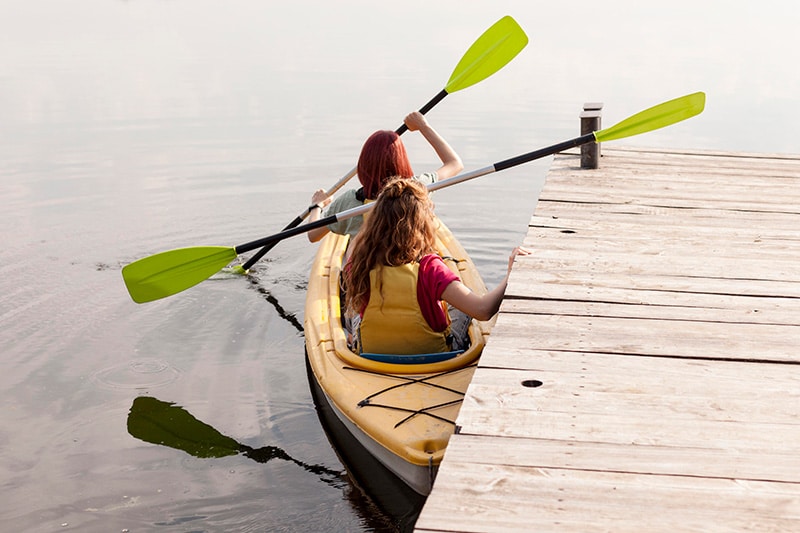You’re looking at kayaks, and you didn’t realize how much there is to consider before you make a decision.
There’s a lot to consider before making a final selection.
Whether you want a kayak for family fun or want to go fishing – there’s a kayak that will meet your needs.
You’ll find below a discussion about the different kayaks out there and their weight limits.
In general, inflatable kayaks have a weight limit of 400 to 750 pounds, while non-inflatable kayaks tend to have a weight limit of 200 to 450 pounds.
This article will cover the different types of kayaks and kayak weight limits, but it’s necessary to discuss why you don’t want to exceed the weight limit of your kayak.
When you exceed the weight limit stated by your kayak’s manufacturer, you will experience your boat going lower into the water than is recommended.
When this happens, you risk taking in water and becoming very vulnerable to waves and rough waters.
Exceeding your kayak’s weight capacity leaves your boat unstable, more challenging, and slower to move, and can increase your chances of capsizing your boat.
In conclusion, you do not want to exceed your kayak weight limit.

Recreational
There are two types of recreational kayaks, the traditional sit-in kind or the ones you sit on top of.
If you enjoy spending time on lakes and calm rivers, then you’ll be more likely to consider a kayak where you sit on top.
If you like doing short tours and you wouldn’t mind a little storage space, then you may want to consider a sit-in kayak.
Whether you buy a sit-in kayak or one you sit on top of, both choices are affordable, easy to turn, and suitable for flat-water journeys.
These kayaks have a weight limit ranging from 200 to 450 pounds, depending on their construction.
If you want to make longer trips or wish to experience rapids or waves, recreational kayaks are not the boats you’re looking for.
If you don’t have space to store a traditional kayak, you can buy an inflatable or folding kayak.
Folding kayaks aren’t as rigid as hard shell ones; however, they have storage and handling comparable to many touring kayaks.
Inflatable kayaks aren’t great if you want to go quickly or venture too far from the shore.
They are wide, rugged kayaks that are good for flowing rivers, and you can enjoy bouncing off obstacles in them.
Because of the buoyancy of inflatable kayaks, they can handle more weight than their hard-shell counterparts.
Their weight limit ranges from 400 to 750 pounds.
Folding kayaks don’t offer as much weight capacity as their hard-shell equivalents.
Their weight limit is, on average, 300 pounds.
Day Touring
Day touring kayaks are versatile boats.
They are more efficient in the water than recreational kayaks, thanks to their sleek shape.
Because of their body, they are easier to control in rough waters. I
f you’re looking for storage, you won’t get a lot in a day touring kayak, but you will get some.
These kayaks are easy to transport, which makes solo road trips to the water more fun!
The weight limit on a day touring kayak is the same as a recreational kayak, ranging anywhere from 200 to 450 pounds.
Touring
You might be wondering what the difference is between a day touring kayak and a regular touring kayak.
The answer is their size and shape.
Touring kayaks are long, strong boats that are incredibly efficient over long distances.
These boats track well because they have either a rudder or a skeg, which helps you deal with strong wind currents.
You get more storage space on a touring kayak so that you can carry snacks for the trip.
Like recreational and day touring kayaks, the weight limit on a touring kayak can range from 250 to 400 pounds.
Tandem
Tandem kayaks are for those who want to enjoy the water with some company.
These types of kayaks can carry two travelers, which makes them more stable on the water.
Because this type of kayak can transport more than one person, the weight limit is slightly higher than the other boats we have discussed.
Tandem kayaks have a weight limit ranging from 450 to 700 pounds.
This boat is an excellent choice for families that are traveling with children.
Fishing
When choosing a fishing kayak, you want to keep the way you fish in mind.
Knowing what kind of fisher you are will determine whether you want a sit-in or sit-on kayak.
If you enjoy fly fishing and sight casting, you want a short and wide, stable boat because it’s easier to stand in.
This type of kayak is slow and not ideal for paddling for any great distance.
It would be best if you kept in mind that sit-in kayaks are harder to recover from when they flip on you.
If you want to travel far in your fishing boat, you’ll want a longer, narrower kayak so that you can travel through the body of water efficiently.
Remember, narrow boats travel faster!
The weight limits on fishing kayaks are higher than other kayaks designed for single travelers because you need to carry all the fish you catch on your trip!
This type of kayak has a weight limit ranging from 400 to 550 pounds.
Next Steps
Now that you know the different types of kayaks and their respective weight limits, where do you go from here?
What does all this information mean for you when looking for a kayak?
You might be wondering if you’ll be okay as long as you fit within the weight limits listed on a given kayak, but there are other things to consider.
Since the chances are reasonable, you won’t be enjoying your kayak empty-handed; you’ll want to take into account the amount of weight you’ll be traveling with so that you buy a kayak that suits your needs on the water and when it comes to the kayak’s weight limit.
You want to make sure that you’re never at risk of exceeding the weight limit in your kayak.
When you’re choosing a kayak, you want to make sure you’re clear on what you plan to do on the kayak to make sure that you’re happy with your purchase and getting the most out of your kayak.
You don’t want a folding kayak if you’re going to want to enjoy rougher waters, and an inflatable kayak isn’t going to cut it if you don’t want to have to stay close to the shore.
There’s a lot to consider when it comes to choosing a kayak.
In addition to the weight limits, you want to look at the storage capacity, the shape and size, and whether you’re more comfortable sitting on top or in the kayak.
With all the variables to consider before making your final choice, you’ll want to talk to an expert who can guide you in the right direction.
You don’t want to rush into buying a kayak and realize afterward that you should have chosen differently based on your needs.
Whatever choice you make, stay safe on the water and have fun!
